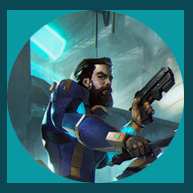As I said in the last article; the more information you have the easier it will be for you to achieve victory in a game of infinity. I’m going to let you know some good methods to glean a little bit of an advantage in your next match.
Before we get started: If I can isolate an enemy without using my hacking device, you can find me in tunguska. Who am I?
Here is the situation; the table is set up and your opponent has deployed. They have finished telling you what their open information units are, and you are wondering what is hidden and what is false.
A well known method of calculating what’s hidden is by counting the points to calculate what information your opponent could be keeping from you. This can be difficult and it requires a deep knowledge of the Infinity factions and units. If you can work out what your opponent’s hidden information is by counting points, then go for it, but an easier and quicker option is to count SWC. This will give you an idea of what your opponent might be keeping as a reserve deployment piece and what might be hidden in marker state.
Another good move is to look for gaps in your opponents list. A 14 unit list can indicate that you will be facing a hidden Deployment unit or a Drop Troop. You should be aware that a cunning opponent will take a list with only 14 units, so the gap can be a bluff.
If there is coherency between models that are placed on the table this can help you to guess what the unseen threats are. For example if there are 3 units that are exactly the same in a coherent line, then you could be looking at a single holoprojection unit. Camo markers that are within coherency of each other can also tell you something. Two camo markers with mimitisim -3 that are within 20 cm of each other are probably some type of minelayer like a Guilang from White Co.
Although I said that counting points values can be difficult, if you want to learn it then the best way to start is with broad approximations. For example if your opponent has only placed cheap troops like REMS and a line troop core, then we can guess that he is holding something big in reserve, even without knowing the exact values of what’s on the table. If we are expecting an expensive unit like a TAG then any anti-TAG tech that we have in our list just went up in value and should be protected.
These are some basic ideas that you might want to pin in your memory if you haven’t heard them before. Once you start using these types of techniques, then you can learn how to counter them. If I know that my opponent is good at deduction, my favorite way of confusing them is spending a command token to hold an extra unit in reserve deployment. Please leave a comment if you have a good way to track what your opponent is trying to hide, or if you have a way to throw them off the scent of what you are trying to do.

Leave a comment